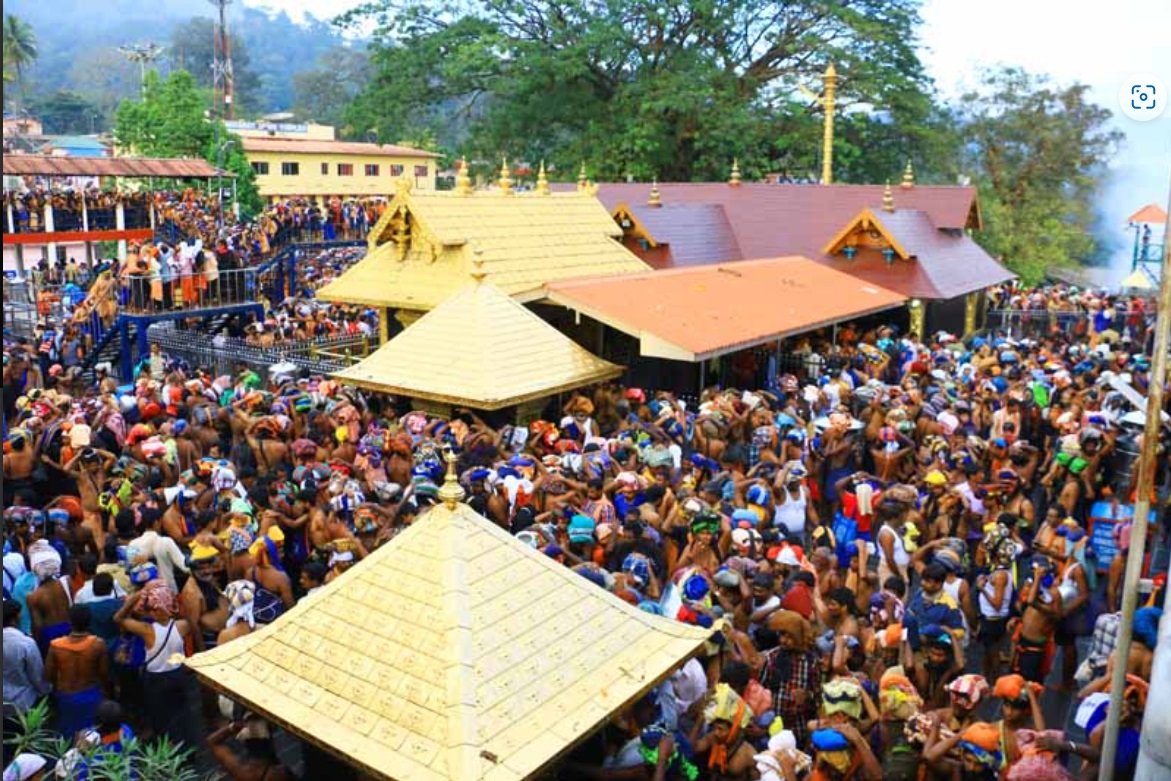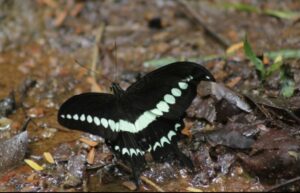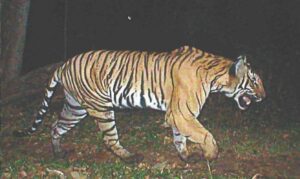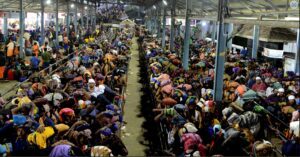An understanding of the butterfly population will help in assessing the region's plant and animal diversities.

Devotees of Lord Ayyappa throng the hill shrine in large numbers every year. (Supplied)
On November 17 last year, the melshanti — or the chief priest — opened the sanctum sanctorum of the Sree Dharma Sastha Temple atop Sabarimala for the 2022-23 pilgrim season.
In six days, 2,61,874 pilgrims visited the shrine located deep inside the forests in Kerala’s Pathanamthitta district, according to official estimates.
The increasing number of devotees keeps the coffers of the Travancore Devaswom Board (TDB), which manages the shrine, ringing.
However, it is now suspected that the heavy inflow of pilgrims is causing environmental decay in the ecologically fragile area.
To ascertain if the influx is causing environmental damage, the state government might turn to an unexpected source: Butterflies.
These fluttering beauties can portend danger.
The hill shrine is one of the holiest places in the country and is not open throughout the year.
Lakhs of devotees from India and abroad visit the Sabari hill — Sabarimala in Malayalam — a part of the Periyar Tiger Reserve (PTR), during the pilgrimage season.
The temple opens for Mandalapuja (November-December), Makaravilakku or Makarasankranti (January), and Maha Vishuva Sankranti (April), besides for the first five days of each month in the Malayalam calendar.
However, as pilgrim footfalls increase annually, Sabarimala is witnessing activities polluting the air, water, and soil — as well as noise pollution.
These, it is suspected, had affected PTR’s ecology as well as the Pamba river at the base station to Sabarimala, some 8 km from the forest shrine.
It is learned that a report from the Environment Committee of the Kerala Legislative Assembly sparked the idea to study Sabarimala butterflies.

Butterflies are good bioindicators since they are more sensitive to environmental threats. Pictured, a Malabar branded swallowtail. (Lekha Susan/Supplied)
The committee, in its report submitted to the Assembly on 17 March, proposed a study on the environmental pollution at Sabarimala.
The study should also cover aspects such as the level of extinction among micro-organisms, butterflies, birds, and wild animals at Sabarimala, and the gravity of ecological changes.
The committee made the suggestions to the state’s Forests and Wildlife, and Environment and Climate Change departments.
“Studies on environmental changes are evolving. One of the methods being adopted now is studying butterflies’ behavioral changes,” a source told South First.
“As butterflies are more sensitive to environmental threats, they are good bioindicators. Thus, conducting such a study at Sabarimala is being explored,” he added.
The feasibility of conducting such a study is being examined and a decision will be taken soon by the authorities concerned.
According to Dr TV Sajeev, chief scientist at the Department of Forest Entomology of the Kerala Forest Research Institute, the presence or absence of butterflies could speak volumes about the local environment.

A tiger caught by a camera trap in the Periyar Reserve. The Pamba river is a major source of water for wild animals. (Supplied)
“Though considered as an indicator to check whether an ecosystem is healthy or not, the services provided by butterflies to the ecosystem are most often overlooked,” he told South First.
He believes that as butterflies are the primary consumers of the food chain, any impact on them will directly reflect on the environment as well.
Caterpillars/butterflies are typically very specific. Some of them feed only on certain plants. They then become food for other animals. Insects, spiders, frogs, lizards, birds, and some small mammals survive on caterpillars/butterflies.
Thus, loss or fragmentation of their habitat might affect other members in the food chain — and thereby the ecosystem.
It is said that an understanding of the butterfly population will help in assessing the region’s plant and animal diversities.
“Even a slight change in climate patterns might affect caterpillars/butterflies. A loss or fragmentation of their habitat means loss of synchrony, as ecological linkages get destroyed,” Sajeev said.
“In short, studying butterflies will give a clear understanding of the local environment,” he added.
Meanwhile, PA Vinayan of the Ferns Nature Conservation Society in Wayanad told South First that at least two years would be required to analyse environmental changes, if any.
“If such a study is being conducted, it is appreciable. By observing butterflies, an overall picture of the biodiversity could be understood,” he opined.
“Plant diversity and butterfly diversity are interconnected. Even a slight impact on one’s diversity could reflect on the other. If conducted properly, the study will help to understand even the microclimatic conditions,” he added.
Another area that the departments concerned might look into is the impact of chemical vermilion used during rituals like Pettathullal — or Petta Kettu — a ritualistic dance performed as part of the pilgrimage.

Devotees queue up at Sannidhanam to scale the sacred 18 steps to the temple. Bleaching powder is used here as a cleaning agent. (Supplied)
“Chemically-coloured vermilion having the presence of metals, including lead, arsenic, and cadmium, are hazardous to the environment. So are the harmful effects of bleaching powder, which is used on a large scale at Sabarimala as a disinfectant,” an official of the Kerala State Pollution Control Board said.
“Their impact on the environment is yet to be studied,” he added.
Incidentally, the Legislative Committee on Environment had warned of the adverse impact of chemical vermilion and bleaching powder on Sabarimala’s ecosystem.
In its report, the committee recommended that TDB ban the sale and use of chemical vermilion at Sabarimala.
Stressing the need for using organic vermilion, the committee also highlighted the need to lessen the use of bleaching powder.
Though green pilgrimage is being promoted, the problem with Sabarimala is that it could not be implemented in toto.
“The pilgrim inflow demands the enhancement of basic amenities such as transportation, comfort stations, medical care, waste management, lodges, etc. All these will influence the environment negatively,” VK Madhusoodanan, an environmental activist, told South First.
“Being a temple that often registers record revenue collections, the government cannot ignore the need for increasing basic amenities or new facilities like the greenfield airport project near Erumely in the Kottayam district,” he added.
Joice K Joseph, who co-authored a 2016 study, Pilgrim Governance, and Environmental Sustainability: A Case Study of Sabarimala Pilgrim Destination, told South First that the pilgrimage has been disturbing the forests.
“Being one of the major shrines in India, the Sabarimala temple is a much sought-after pilgrim tourism destination,” he said.
“The hill shrine is most likely to be featured in the PRASAD scheme (meant for developing pilgrimage centers), Swadesh Darshan scheme (theme-based tourism), and tourism circuits of the Union and state governments. These will attract even more devotees, which in turn will hurt the environment,” Joseph opined.
Earlier, the Comptroller and Auditor General of India (CAG), in a 2018 report, highlighted that the Sabarimala pilgrimage topped the list of 18 major threats identified by the PTR under the Tiger Conservation Plan.
The CAG pointed out that the increasing number of pilgrims and the growing demand for additional land for infrastructure development at Sabarimala led to habitat degradation.
Referring to the sewage treatment plants set up in the area, the CAG also observed that the overflowing wastewater mixed with the Kumbalamthodu, a stream, which in turn emptied into and polluted the Pampa river.
The river is a major source of water for wild animals.
Ironically, according to a brief note on PTR prepared by the National Tiger Conservation Authority, the Sabarimala shrine is in the buffer area of the reserve, and the zone limits the anthropogenic disturbances from affecting the core tiger habitat.
The authority also noted that management of the growing trend of visitors to the shrine is one of the challenges the PTR has been facing.

Apr 25, 2024

Apr 25, 2024

Apr 25, 2024

Apr 24, 2024

Apr 24, 2024

Apr 24, 2024